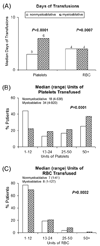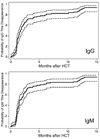The impact of donor type and ABO incompatibility on transfusion requirements after nonmyeloablative haematopoietic cell transplantation
- PMID: 20067562
- PMCID: PMC2864362
- DOI: 10.1111/j.1365-2141.2009.08073.x
The impact of donor type and ABO incompatibility on transfusion requirements after nonmyeloablative haematopoietic cell transplantation
Abstract
We retrospectively analyzed transfusion requirements within the first 100 d among allogeneic haematopoietic cell transplantation (HCT) recipients with haematological malignancies given either myeloablative (n = 1353) or nonmyeloablative conditioning (n = 503). We confirmed that myeloablative recipients required more platelet and red blood cell (RBC) transfusions than nonmyeloablative recipients (P < 0.0001 for both). Myeloablative patients given peripheral blood stem cells required less platelet transfusions (P < 0.0001) than those given marrow while RBC transfusion requirements did not differ significantly. Subsequent analyses were restricted to nonmyeloablative recipients. Platelet and RBC transfusions were less frequent among related compared to unrelated recipients (P < 0.0001 for both), with comparable median numbers of transfused units. Major/bidirectionally ABO-mismatched recipients required more RBC transfusions than ABO-matched recipients (P = 0.006). Rates of graft rejection/failure, grades II-IV acute and chronic graft-versus-host-disease (GVHD), 2-year relapse, 3-year survivals and non-relapse mortality were comparable among ABO-matched, minor-mismatched, and major/bidirectionally mismatched recipients (P = 0.93, 0.72, 0.57, 0.36, 0.17 and 0.79, respectively). Times to disappearance of anti-donor IgG and IgM isohemagglutinins among major/bidirectionally ABO-mismatched recipients were affected by magnitude of pre-HCT titres (P < 0.001 for both) but not GVHD (P = 0.71 and 0.78, respectively). In conclusion, nonmyeloablative recipients required fewer platelet and RBC transfusions and among them, both unrelated and major/bidirectionally ABO-mismatched recipients required more RBC transfusions. ABO incompatibility did not affect nonmyeloablative HCT outcomes.
Keywords: ABO-incompatibility; allogeneic HCT; nonmyeloablative conditioning; transfusion.
Conflict of interest statement
Figures






References
-
- Anasetti C, Amos D, Beatty PG, Appelbaum FR, Bensinger W, Buckner CD, Clift R, Doney K, Martin PJ, Mickelson E, Nisperos B, O’Quigley J, Ramberg R, Sanders JE, Stewart P, Storb R, Sullivan KM, Witherspoon RP, Thomas ED, Hansen JA. Effect of HLA compatibility on engraftment of bone marrow transplants in patients with leukemia or lymphoma. New England Journal of Medicine. 1989;320:197–204. - PubMed
-
- Badros A, Tricot G, Toor A, Morris C, Guo C, Munshi N, Barlogie B, Cottler-Fox M. ABO mismatch may affect engraftment in multiple myeloma patients receiving nonmyeloablative conditioning. Transfusion. 2002;42:205–209. - PubMed
-
- Baron F, Vanstraelen G, Beguin Y. Transfusions after nonmyeloablative or reduced-intensity conditioning regimens. Leukemia. 2006;20:2081–2086. - PubMed
-
- Benjamin RJ, McGurk S, Ralston MS, Churchill WH, Antin JH. ABO incompatibility as an adverse risk factor for survival after allogeneic bone marrow transplantation. Transfusion. 1999;39:179–187. - PubMed
-
- Bolan CD, Childs RW, Procter JL, Barrett AJ, Leitman SF. Massive immune haemolysis after allogeneic peripheral blood stem cell transplantation with minor ABO incompatibility. British Journal of Haematology. 2001a;112:787–795. - PubMed
Publication types
MeSH terms
Substances
Grants and funding
LinkOut - more resources
Full Text Sources

